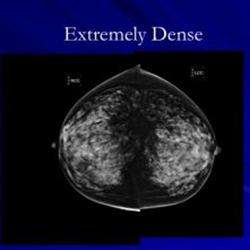A New York state law that goes into effect Jan. 19, 2013, could impact up to half of all women who get annual mammograms, according to Avice O'Connell, M.D., director of Women's Imaging at the University of Rochester Medical Center and Highland Breast Imaging.
The law, passed in July of 2012, standardizes clinical practice by requiring mammography providers to inform women if they have dense breast tissue. Up to 50 percent of women have dense tissue of some degree, O'Connell said.
"Dense breast tissue itself does not lead to cancer," she said. "But dense tissue does make cancer harder to detect with a mammogram alone."
On mammography images, a cancerous mass appears white, but it can be disguised by dense breast tissue surrounding it, which is also white.
Radiologists list four categories of breast density. According to the new law, women whose breast tissue is deemed to be "extremely dense" or "heterogeneously dense" – the two highest levels of density – will be notified by their providers in a letter following the screening. The letter also will suggest that women talk with their doctors about personal risks for breast cancer and additional screening options.
One important breast cancer risk factor is family history. Based on an assessment of density and a woman's personal risk, her physician may recommend that she have supplemental testing, such as ultrasound screening. The law does not require insurance to cover screening ultrasounds, but most of the major insurers have indicated they will cover the additional procedure with a physician's referral.
"An ultrasound gives us a different view of the breast tissue," O'Connell said. "The drawback is we will find many small, solid masses that will need to be biopsied or followed, and at least 90 percent of the time, they will turn out to be benign. However, it is worth it for women whose breast cancer is not found on a mammogram but is detected in an ultrasound."
Breast density is one of many risk factors for breast cancer, but its specific effect is still being discussed in the scientific community. Women with dense breasts who are not at an increased risk of breast cancer due to family history and other factors may choose not to have further testing beyond a mammogram.
Provided by University of Rochester


















